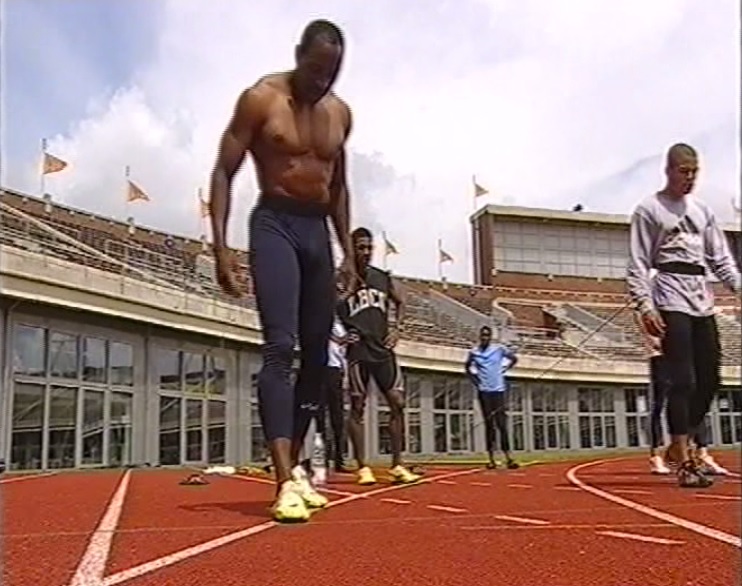And our world is full of them, here is a misunderstanding about a popular issue in sprints training and a questions that I have heard since I started working with this:
“As far as resisted sprint training goes e.g. sled towing: how heavy should the sled be?”
Below a possible answer from Jimson Lee’s excellent website “Speed endurance”
Citation:
“My quick answer has always been 10% of your body weight. If you weight 80kg, that’s 8kg, and you in have to account for the weight of the sled. If you are low on cash, simply use a car or truck rubber tire, and use sandbags for additional weight. Why 10%? Because Charlie Francis said so.
But serious, he did say 10%, and we experimented with it. We found going too high, say 20%, the athletes were struggling to keep the same form and the ground contact was substantially increased. I don’t have any scientific proof of that, but you can just see and hear it.
In this month’s Journal of Strength & Conditioning Research, May 2014, Vol28, No.5, pg. 1241-1245, they studied the effects of Sled Towing on Sprint Starts.
The results are suggesting 20% weight on sleds instead of 10%.” End of citation.
My idea: the weight of the sled is not all that important, if one is sprinting on a wet synthetic track e.g. after rain, the weight could be very high, but the lack of friction still would result in low added resistance. So the weight, expressed in kgs of lbs or in percentage of body weight is of no value.
My concept is that the added weight and friction (= resistance) should result in a time loss of more than 10% of the time compared to the time ran without the resistance.
So if your 30 meter standing start is 4.00, than with resistance (any kind of resistance), one should not be running the 30 meter standing start slower than 4.40.
It strikes me as strange that the article in JSCR also uses the body weights percentage as a parameter to judge the resistance. Apart from the fact that they did not really measure the training effects of the 10% vs 20% sled over time.
PS. Charlie anyhow wasn’t a fan of resisted sprinting nor of assisted or supramaximal sprinting, but if he really spoke about 10% of body weight it just shows that not all of his ideas were right.

Here is another one: there are more ways to interpret research:
Crossfit-Based High-Intensity Power Training Improves Maximal Aerobic Fitness and Body Composition by Smith, Michael M.; Sommer, Allan J.; Starkoff, Brooke E.; JSCR 27(11):3159-3172, November 2013.
The main outcome of the study is that a 10 week HIPT (crossfit) increased VO2max in men from 43.10±1.40 to 48.96±1.42 ml/kg/min and in women from 35.98±1.60 to 40.22±1.62 ml/kg/min.
Also the researched measured a decreases in fat percentage of 22.2±1.3 to 18.0±1.3 in males and in females from 26.6±2.0 to 23.2±2.0.
Well, isn’t that great new for the crossfit fans? Yes, it looks like it: losing fat and improving VO2max without “real” boring cardio stuff like on treadmills or bikes.
But……. the critical reader also would have read that:
Citation 1: “Subjects had already been following a “Paleolithic” type diet prior to and following completion of the training protocol”
So was the loss in fat due to the crossfit program or to the diet?
Citation 2: “16% of total recruited subjects) citing overuse or injury for failing to complete the program and finish follow up testing” Are you still with me? The program managed to injure 16% of the participants in only10 weeks?
Can you afford to lose 16 % of your athletes in only10 weeks? Well…….. I can’t!
How many athletes would be left after a years on this program?
Let these articles be an example of how careful and critical one has to be in reading, interpreting and applying information. The effort of your athletes and your time are probably too valuable to waste.

I believe Charlie Francis stated that it was 10% of 30m time and not bodyweight. He believed that Heavy Sleds, resulted in longer foot contact times and bad sprinting technique.
Henk, do you prefer Hills or Sleds?
Sleds seem to stress the CNS a lot quicker compared to a Hill session. I have no scientific proof other then the circles under my athletes eyes the next day! One season we did hills only with good results in accelerations, the next season, sled only, with not so good results, more stress effecting the rest of the day/weeks training.
Hello John, Yes, Charlie’s opinion explains the title of my post.
My preference is working with the sled, simple:
1. adjustable resistance on an individual basis (I cannot chose the incline of the hill, so for some athletes a certain hill might be to steep, while for others it isn’t steep enough)
2. proper and specific surface (synthetic allows my athletes to wear spikes)
3. resistance decreases as distance progresses (like in the race)
4. sled is portable (at least the one I use), I can find weights at any track)
5. I can use the same sled also for pulley running (supramaximal)
Not to mention that these studies look at results over just 10 weeks. The program that works best over 10 weeks and the program that works best long-term are not always the same.
We always found CrossFit great for sales but short on solid theory.
Bruce Evans, Co-founder of Dynamax Medicine Balls